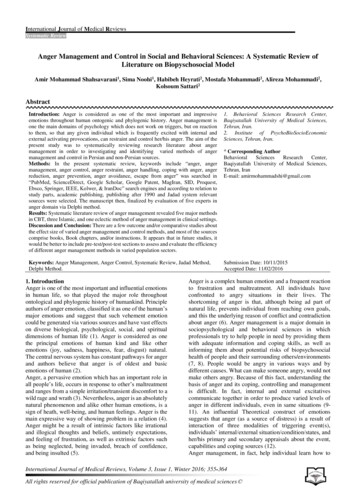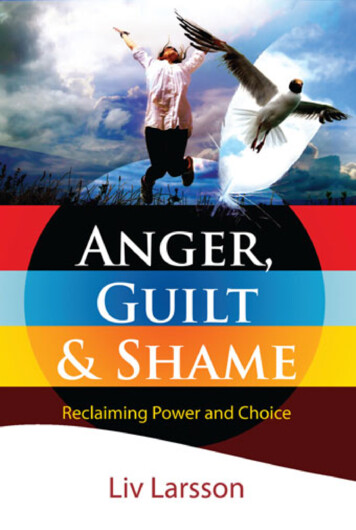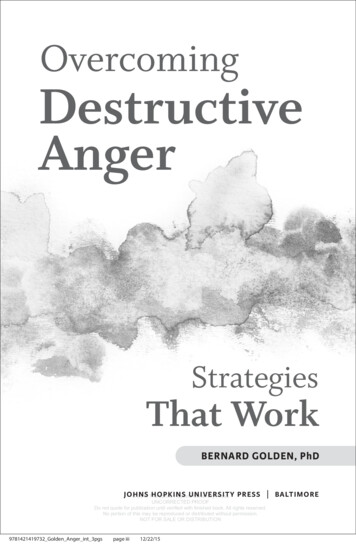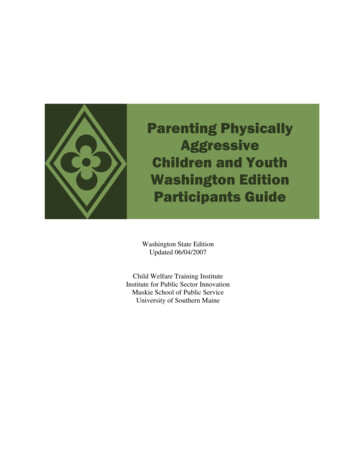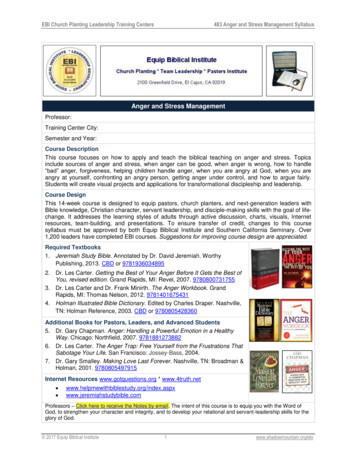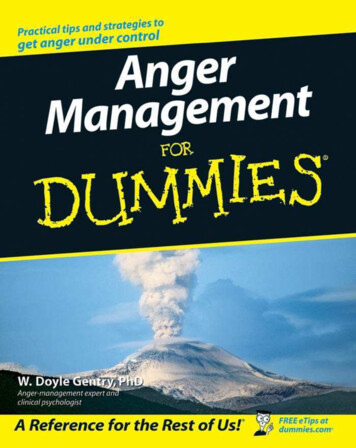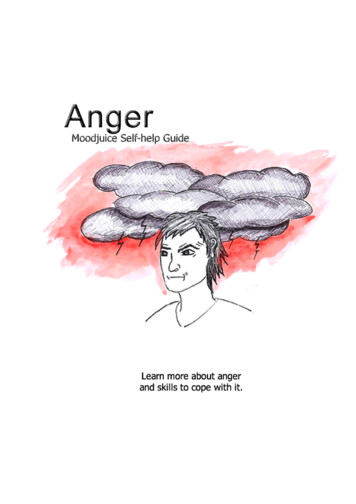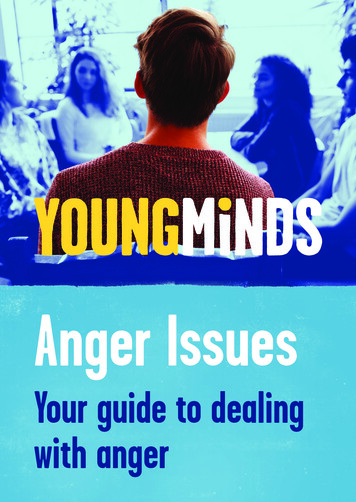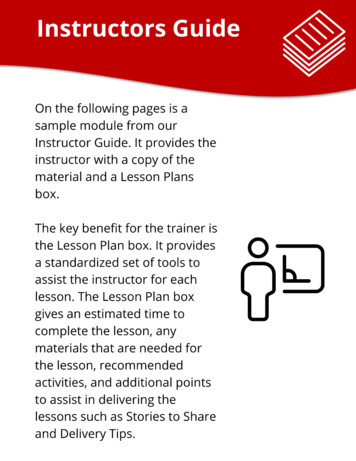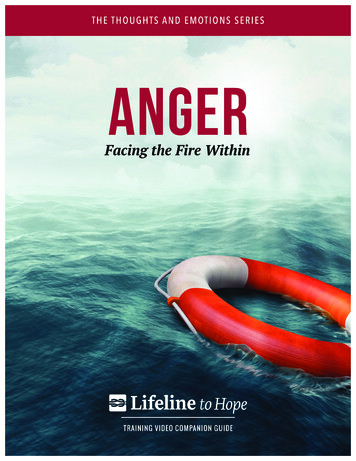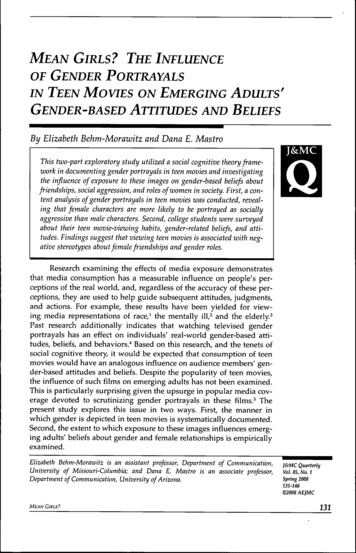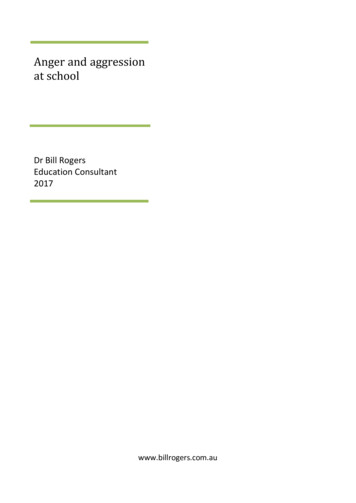
Transcription
Anger and aggressionat schoolDr Bill RogersEducation Consultant2017www.billrogers.com.au
1Angry and aggressive childrenWhen were you last really angry? – not just annoyed, irritated, or a littlefrustrated but angry. Anger is the most extreme of our emotions. It can driveus to meet what we believe is our ‘fight for justice’; it can also drive us to doand say hurtful, destructive, things; even to those we love. Understandingand managing our own anger (as adults) is an important pre-requisite forhelping children understand their own frustration, anger and aggression. Ifwe find it hard – at times – how hard must it be for them?The angry face – anger is not a ‘bad’ emotionIn children’s picture and activity books addressing feelings, you will often see a series ofillustrations (or photos) of faces with a variety of facial expressions (as in emoji’s). Thecaption usually reads something like :- ‘What are these people feeling?’ Amongst thosefaces children will see ‘the happy face’, ‘the anxious face’, ‘the sad face’, and ‘the angryface’. Children are pretty good at recognizing all the faces – including what an ‘angry face’looks like – but sometimes they are not always adept at knowing when they feel angry (orwhy?); or understanding why someone else is angry. Children need to learn about thefeelings associated with frustration and anger and this is where teachers can beconstructive and supportive.Children need to know that anger itself is not a bad emotion. Happy and sad feelings canoften appear to be somewhat ‘black’ and ‘white’ to young children and adolescents (evensome adults), but anger is a difficult feeling to categorise for children. They need tounderstand that they are not ‘bad’ for having these feelings. Being angry and showinganger is not – in itself – bad. It is the way we behave when we’re angry that really matters.Children need the chance (as we all do) to vent their feelings and share them in helpful,safe and reasonable ways.The ‘range’ of emotional arousal .Children also need to learn the difference between concern, irritation, annoyance andfrustration and ANGER. Of course frustration has degrees of significance in its perception Dr Bill Rogers 2017 Anger and Aggression at School (1)
2and frustration-tolerance is a crucial social/relational feature of our development. Childrenneed to learn (as we all do) that life will not always be ‘happy’, ‘easy’, ‘fun’, ‘OK’ . Whileresilience behaviour is not the topic of these notes, the ability to tolerate, and dealconstructively with frustration is a crucial feature of resilience behaviour.They also need to learn that aggression is different from the emotion of anger. Childrenneed the opportunity to say what it is that makes them angry and why. This needs to betaught – especially to boys. Some angry actions or angry behaviour are inappropriate,some are clearly unacceptable and wrong; children need to learn this.It also helps children if we teach them what happens in, and to, their bodies – and theirthinking – when the emotion of frustration-anger comes. Our heart rate changes, we tenseup in face, brow, shoulders, neck, stomach, we breathe more shallowly/rapidly . Whenfrustration/anger is ‘intense’ the fight/flight response may well be a common expression inthe way children deal with the emotions associated with frustration and anger.In counselling a child with anger issues we often use drawings to illustrate, discuss andexplore the fundamental physiology of anger arousal. This awareness will always help inanger-management support. (See Rogers and McPherson, 2014).Anger – as an emotion – is neither good nor bad.As noted, it is very important that we do not convey to children that they are bad because(or when) they get angry. Difficult as it is, we need to help children understand thedifference between angry feelings and angry behaviour. As adults, we can’t help ‘getting’annoyed and very frustrated or angry at times (although some children and adults do have‘low-frustration-tolerance’); we can learn to behave more constructively when we’refrustrated and angry.Some children have learned that hostile and aggressive expressions of feelings offrustration are ‘acceptable’, or can get their immediate needs met. They see it in nonschool settings, on TV, in sport, sometimes in their home. Angry behaviour is learned.When a child behaves with aggressive angerWhile a teacher should always be empathetic about the difficult, and dysfunctional,circumstances (from home) that predispose some students’ behaviour, we should never Dr Bill Rogers 2017 Anger and Aggression at School (1)
3tolerate – or play down – lashing out by biting, spitting, kicking; screaming, yelling, abusiveswearing; punching; or throwing objects .When a child ‘stabs’ another on the arm with a pencil, or threatens another with scissors,or purposefully pushes, or trips, or punches because they don’t like – or are frustrated by aclassroom peer (or teacher) – we should quickly, firmly and assertively address suchbehaviour. Eg : “No / Stop ( . ). We do not bite. Ever.”, “Stop . biting is NOT OK”.Eg :- When we remove scissors from a child, (where they are using them threateningly)we don’t ask them to hand them to us (when the child is visibly angry with a pair ofscissors or pencil, or .!). Direct them, firmly and calmly, to ‘put them down – now’; thenpursue the calm use of time-out (see McPherson and Rogers, 2014). It needs to becommunicated to the individual that such behaviour is unacceptable and will not betolerated. The ‘audience of peers’ needs to hear, and see, adult protective leadershipregarding any such behaviours.All children have a right to feel safe (emotionally and physically safe) at school.At infant and early years level we need to show a brief, firm, disapproval of hostile andaggressive behaviour and we may need to direct the offending child to time-out. “Wenever poke people here Sean (focus specifically on the behaviour)”. If the child protests“But he took my pencil (or )” we avoid arguing or taking sides. If necessary direct thechild to work at another place in the room, or for more aggressive behaviours we will directthe child (or children) to take organised cool-off time (time-out).Time-out (cool-off-time)Cool-off time is often essential for very frustrated or angry children particularly when it isaffecting other children’s safety. It is pointless trying to get to ‘the reasons’ for their hostileor aggressive – angry – behaviour in the heat of the moment. And, when ‘losing it’ – it ispointless trying to reason with the child . Cool-off time should be exercised calmly,respectfully, firmly, decisively (in-class cool-off time or exit from the class time-out ifnecessary). It is crucial to have a whole-school plan for any use of ‘time-out’ (Rogers,2011 and McPherson and Rogers, 2014).Working in a grade Prep (recently) as a mentor-teacher (team-teaching for behaviourleadership) a five year old boy who has significant temper/anger issues said to me, in a Dr Bill Rogers 2017 Anger and Aggression at School (1)
4one-to-one chat that he could ‘fake a melt-down’ (sic)! “I can fake a melt-down and I havereal melt-downs too when I don’t want to do something I don’t like .” This was a verybright 5 year old lad (with family issues . single parent / some domestic violence issues, acontrolling father .). On several occasions he had stood in the classroom – in front ofother children – displaying loud temper tantrums. At one point he had stood in the middleof the classroom, after kicking over his chair, screaming at me, “I’m not listening to you!! Ihate you!! You can’t tell me what to do!!” (He’d also displayed this ‘self wind-up’/’meltdown’ behaviour with his regular teacher too – the teacher I was mentoring).On these occasions my colleague would calmly, firmly, respectfully and decisively escorthim to in-class cool-off-time (time-out). If a student refuses to go to in-class cool-off-time[sitting away from all others in the classroom for five minutes or so], or starts yelling,kicking, throwing things in the in-class cool-off-time, a senior teacher is called for who willcalmly. firmly, respectfully and decisively escort the child from the classroom to asupervised time-out place (normally for the rest of that class period).There are occasions when a child will not leave the class even for a senior teacher (adeputy or principal ). We cannot let a 5 year old (any child) hold the class – effectively –to ransom by a melt-down; a real loss of self-control or, as Jayden had told me, even afake melt-down (!). On these occasions (rare) the senior teacher will stay with the child inthe classroom and the class teacher calmly, respectfully, escorts the class away from theclassroom. This approach to time-out addresses the nature, and effect, of peer audienceand not easily reinforcing the child’s attentional/power-seeking behaviour. If we cannotcalmly escort the child from his audience we will escort his audience away from him. It iscrucial – in this approach - not to humiliate the child we leave in the supervised care of thesenior colleague at this point. We are conveying to all the students that we will not let anyone person in our class/school take away our right to feel safe here or to learn here (withscreaming, threatening, hurtful behaviours .).The teacher and I also worked with Jayden on a personal behaviour plan to teach himfrustration recognition, frustration tolerance and self-coping/calming skills (see theexample later p 9).Children, like Jayden, know where their behaviour is wrong; they also need to know that ifthey continue to create significant disruption to others’ learning or safety or fair treatmentthey will have to face time-out. Time-out is a necessary behaviour consequence. Dr Bill Rogers 2017 Anger and Aggression at School (1)
5Exercised with dignity and respect it sends a message to all children (not just the‘tantrumming’ student) that teachers will lead for and maintain a safe classroom(psychologically as well as physically).Time-out, however, cannot – by itself – teach the alternative behaviours that some childrenwill need to learn to understand and manage their emotions. This is where behavioursupport plans come in (Rogers, 2003; Rogers, 2009; Rogers and McPherson, 2014).Longer-term supportOur aims for any longer-term behaviour support should include teaching children to : recognise the situations or circumstances that lower their tolerance to frustration; understand and be aware of their feelings and emotions; learning to ‘tune into’ their body when frustration comes . learn to communicate how intensely they feel (without resorting to verbal or physicalaggression); learn a ‘vocabulary of emotion’ (Rogers, 2003 and McPherson and Rogers, 2014) to‘label their feelings’ and express and communicate how much they feel about agiven situation, circumstance or relationship (eg : annoyed, upset, irritated a little bitfrustrated, very frustrated, angry ); learn self-calming skills (see later); learn strategies, and skills, to manage their own anger or cope with others’ anger.Communicating with a child when they are frustratedIt is important to calmly and briefly tune-in to a child’s feelings when they are angry andhelp refocus a child to appropriate behaviour. If they are too emotionally ’worked-up’, wewill need to organise ‘cool-off time’, or even time-out away from the classroom to enablethat refocusing. “I can see you are feeling (really) upset, what you need to do now is .”.On rare occasions where angry behaviour is dangerous we may need to restrain childrenwho are a significant danger to themselves or others (thankfully this is normally rare). Anyrestraint procedures should be well understood by all staff in policy and practice (seeMcPherson and Rogers, 2014).At some stage (after cool-off/time-out time) it will important to follow-up, one-to-one, with achild to help them understand the differentiation of anger-feeling and anger-behaviour. Dr Bill Rogers 2017 Anger and Aggression at School (1)
6For example in the immediate moment of the anger episode : “I can see you’re veryannoyed, (upset, concerned, frustrated, fed-up, angry) ” or, after the anger episode, “Icould see that you were .” By tuning in to a child’s probable feelings we help them withshort-term self-awareness and the possibility of some self-control. Essentially it is calmlyacknowledging their feelings (this is not the same as simply saying we ‘understand’ howthey feel or, necessarily, approve .) as when a teacher says to a student :- “To havesomeone say things like that can be very upsetting (name the feeling eg. : frustrating,annoying, upsetting, hurtful) ”, it can help make it easier for that student to believe theirteacher at least understands. Denying a child’s feelings is tantamount to judging a child.Before we can help them (long-term) with more appropriate ‘emotional behaviour’ we needto demonstrate we can and will listen (at a calmer moment) (Rogers, 2003 and McPhersonand Rogers, 2014).If a student has significant, and on-going problems with anger we also need to help themlearn more appropriate ways of expressing anger than just lashing out, or physicallyhurting others, (see later).It is also important to teach children a ‘vocabulary of emotion’ so they do not easilyoveruse the word ‘angry’ when it is ‘inappropriate’ (“I’m angry ‘cos he took my red pencil !”).A framework for teaching anger management to childrenWhen we teach children within an anger-management support plan : Teach the child about the links between angry thinking, angry feelings and angrybehaviour (simple drawings as ‘social stories’, even safe role-play can all help frame,extend and develop understanding). We teach the basic physiology of anger. With older primary children we can explain and model that angry thinking ( eg “I hatehim!!” All teachers are horrible, unfair, nasty !!”, “No-one cares about me!”) affectshow uptight we feel (this is particularly helpful for older children). How wecharacteristically think, self-talk and rate stressful experiences significantly affects thedegree of natural emotional upsetedness. This, in turn, can have a significant effect onresulting behaviour. Dr Bill Rogers 2017 Anger and Aggression at School (1)
7 Teach the child strategies for ‘self-calming’ (relaxation words; clench / unclench anduntense face and fists and shoulder muscles; counting backwards from 10; calmbreathing as distinct from deep breathing .). See later.The bigger pictureChildren get frustrated or ‘angry’ for the same reasons adults do : normal life frustrations,conflict over possessions; emotional and physical teasing; hostile or aggressive acts(being pushed, shoved or even hit); verbal abuse and bullying (put-downs, lying aboutsomeone, ‘dobbing’). (Marion, 2000, Rogers, 2007 and McPherson and Rogers, 2014).‘Aggressive anger’ is often the result of the build-up of frustration and the feeling of having‘no-control’ (losing control). Some children (and adults) have a very low tolerance tofrustration; and the ‘emotional/physiological/behavioural gap’ between frustration andaggression is very ‘narrow’(!). It can help if a teacher – noticing a child easily and quicklygetting angry – to quietly tune-in to the child’s probable emotional state and acknowledge(and name) what they are probably feeling at this point. A child may also need to berefocused, or re-directed, to appropriate behaviour, or may even need cool-off time untilthey can regain self-control. It is also important to distinguish between the occasionalangry outburst and the characteristic expressions of inappropriate anger behaviour.There is a very helpful picture-story book for children, Danny in the ToyBox (Richard Tulloch and Armin Greder), about a little boy who getsvery cross and illustrates how he handles his temper. Its gentle andrealistic humour can help children (and adults) gain an insight into thisstrong emotion. I’ve used this book with whole-class groups as well asindividuals.Anger management plansSome children will benefit from an individual behaviour management plan :--That teaches that anger as a ‘feeling’ is not bad we all get angry. Dr Bill Rogers 2017 Anger and Aggression at School (1)
8-Teaching the child to recognise what happen in/to our body when we feel veryfrustrated . (even the ‘fight’/’flight’ response ).-Teaching the child the do bit of anger :- how we think, what we think, how webehave with words and actions WHEN we get angry is something we can changefor the better; “better for us, better for others”. This includes the understanding thatthinking is also a ‘behaviour inside our head’.-Teaching the child the awareness of body sensation, tuning-in and untensing face,shoulders, neck muscles, counting backwards (10 . 0) can help in initial calming.Using calm breathing, (as distinct from deep breathing) : breathe in calmly for acount of 2 (or 3 for older children) hold for a count of 3, then breathe out for a countof 2 (or 3 for older children). These skills are practised one-to-one (child andteacher, or child and teaching assistant) with the child in the behaviour supportsessions.-Teach the child to be aware of situations and circumstances that lower theirtolerance to frustration; an anger-diary can help to chart the ‘trigger factors’ Rogers, 2003). Self-awareness is a key factor in self-monitoring and self-directingof any behaviour – crucially so with frustration and temper.-Teach the child key ‘words’ or ‘phrases’ he can say to others when he is upset,annoyed, irritated, frustrated or even angry, eg “I don’t like it when ”, “I am angrybecause ”, It can also help to teach the child some fundamental ‘I can’ statements : ‘I can calmmyself when I am getting annoyed or frustrated .’, ‘I am breathing calmly .’, ‘I amuntensing my muscles .’ ‘I can do .’ (instead of ‘I’ll never be able to’, ‘I can’tcontrol ’). In these cases we can teach simple cognitive reframing skills in one-toone practice sessions with the child.-Teach SICOT : self-imposed cool-off-time where a child can rest his head in hishands (even at his table group/desk), close his eyes (adding the cognitive countingand calm breathing and untensing). This can be a helpful alternative to time-outaway from others. Dr Bill Rogers 2017 Anger and Aggression at School (1)
9What follows are some examples of plans we have used with children. It is not the ‘quality’of the drawing – many colleagues use simple ‘stick figure’ drawings with children up tomiddle school years. The drawings act as social stories and as personal aide memoiresfor the child during classtime. (Rogers, 2003, Rogers and McPherson, 2014).With any such plan it is important to encourage a child’s efforts at positive angermanagement back in classroom contexts. For example, rather than a student easily Dr Bill Rogers 2017 Anger and Aggression at School (1)
10resorting to verbally or physically ‘fighting’ to deal with a squabble, a problem or a conflictlet them know it is O.K. (not ‘weak’) to ask an adult (a teacher or aide) to help out whenthey feel frustrated or angry “Sean, we all get angry feelings sometimes ” I find it helpful to indicate some non-verbalcues (at this point) here to simulate – to the student – the emotion by ‘a frown’, or by a‘churning motion near the tummy’ , or ‘clenched fists and jaw, shoulders’ “Have younoticed what you do – and say – when you feel like that ?” It is, then, important to helpthe child be aware of what he then normally does when he feels like that and the effecttheir behaviour has on others. From these kinds of discussions we – then – work with thestudent on a behaviour support plan (see examples on p 9).Chill out, calm myself down and then refocusYes, I know I’m getting really annoyed, frustrated So; I’ll remember my plan :1)Close eyes, count back from 10 :10, 9, 8,7, 6, 5, 4, 3, 2, 1, 0.2)Calm breathing for a few minutes : slow andcalm; breathe in count1, 2, 3, hold 1, 2, 3 breathe out (slowly) 1,2, 3.3)Untense face, shoulder muscles.4)Self cool-off-time? Feeling better? Lessuptight? More ‘in control’ now? Dr Bill Rogers 2017 Anger and Aggression at School (1)
11 Dr Bill Rogers 2017 Anger and Aggression at School (1)
12Relational managementOn occasion, mediation strategies can help when a child’s frustration leads to angry verbalor physical behaviour directed to another student (or teacher). After ample cool-off timethe mediation process can enable the student concerned to understand the effect hisbehaviour has on others’ feelings. As a result they will know that while such angrybehaviour is wrong, they (as a person) are not rejected; that a relationship can be reestablished. Children will also be encouraged and directed to understand that (whereappropriate) restitution may be required.Where apologies are right and necessary we also add that ‘sorry words’ also need to befollowed by sorry behaviour, so the other person can see you are actually sorry through‘what you now do.’.The relational-behaviour issues of frustration and anger may also need to be ‘formally’discussed with the whole class as part of the overall classroom-behaviour agreement(Rogers, 2003) and also – as occasions arise with individuals – as part of a classroommeeting. Such ‘meetings’ will need the child’s understanding and permission and need tobe conducted sensitively and constructively. It will also be important to share this with theparent of the child in question. In some cases we will ‘enrol’ the child in anothergrade/class while we conduct this sensitive issue of any individual child’s behaviour withina class-meeting format.A classroom – a school – has to be a safe place for our children (and teachers!). Childrenhave to learn to get along with a wide range of people (often in a small space, under thenormal expectations of teaching and learning and social relationships). While it is obviousthat some children will have less positive experiences than their peers, and will have seenadult models expressing feelings of frustration and anger in hostile and hurtful ways,teachers can greatly assist students’ awareness, about feelings and anger, through wholeclass dialogue; positive stories, classroom-meetings, positive discipline andencouragement and individual-behaviour support plans. Dr Bill Rogers 2017 Anger and Aggression at School (1)
13What we hold on to, as teachers, is that frustration-anger behaviour is ‘learned’;dysfunctional anger behaviour can be un-learned and more appropriate anger behaviourcan be relearned.A helpful start for individuals (and even whole-class learning) are relaxation activities forchildren. See particularly, the excellent text :- Relaxation For Children by Jenny Rickard,(ACER Press). Dr Bill Rogers 2017 Anger and Aggression at School (1)
14ReferencesBERNARD, M and JOYCE, M. (1984) Rational-Emotive Therapy With Children andAdolescents New York : John Wiley and Sons.MARION, M. (2000) Guiding young children’s understanding and management of anger.In Education Horizons Vol. 6, No. 3 pp 5-8.RICKARD, J. (1992) Relaxation Activities for ChildrenCamberwell, Victoria : ACER Press.ROGERS, B. (2003) Behaviour Recovery : A Whole-School Approach For MainstreamSchools [In the U.K. published by Sage Publications : London].ROGERS, B. (2006) Behaviour Management : A Whole-School Approach[In the U.K. published by Sage Publications : London].ROGERS, B. Ed (2009) How to Manage Children’s Challenging Behaviour. SecondEdition. There are some very helpful case studies in this book, written by teachersworking with at-risk and challenging children. Sage Publications : London.[Available in Australia from :Footprint Books1/6A Prosperity Pde.,Warriewood NSW 2102(02) 9997 3973 www.footprint.com.au ]ROGERS, B. and MCPHERSON, E. (2014) Critical First Steps : Behaviour ManagementIn the Early Years. Curriculum Corporation : Melbourne. Second Edition.[In the U.K. : Behaviour Management With Young Children : Crucial First Steps WithChildren 5-7 Years. Sage Publications : London (2009)].Dr. Bill Rogers is a teacher, education consultant and author . He conducts in-servicesand seminar programmes across Australia, New Zealand, Europe and the U.K. in theareas of behaviour management, effective teaching, stress management, colleaguesupport and teacher welfare. He has also worked extensively as a mentor-coach inclassrooms; team-teaching in challenging classes in Australia and the U.K. {He is a Fellowof the Australian College of Educators and Honorary Life Fellow of Leeds Trinity Universityand Honorary Fellow at the Graduate School of Education, Melbourne University}. Dr Bill Rogers 2017 Anger and Aggression at School (1)
15Appendix to notes :Anger and Aggression at SchoolThese notes/illustrations are drawn from discussions with students around their commonperceptions about frustration and anger. They note the typical concerns, responses andways of focusing on how to reduce and deal with frustration and anger.Bill Rogers Dr Bill Rogers 2017 Anger and Aggression at School (1)
16 Dr Bill Rogers 2017 Anger and Aggression at School (1)
17 Dr Bill Rogers 2017 Anger and Aggression at School (1)
18 Dr Bill Rogers 2017 Anger and Aggression at School (1)
19 Dr Bill Rogers 2017 Anger and Aggression at School (1)
20 Dr Bill Rogers 2017 Anger and Aggression at School (1)
the way children deal with the emotions associated with frustration and anger. In counselling a child with anger issues we often use drawings to illustrate, discuss and explore the fundamental physiology of anger arousal. This awareness will always help in anger-management support. (See Rogers and McPherson, 2014).
